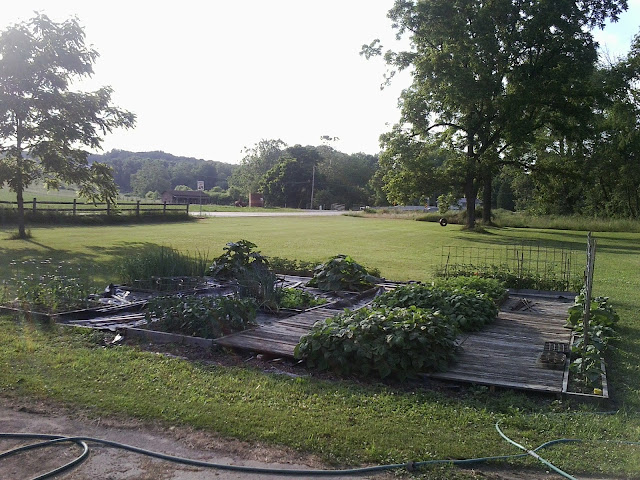With the abundance of warm weather and rain we've been getting, I decided that last Friday was the perfect time to get everything planted, except the tomatoes and peppers. So I started cleaning out boxes, pulling weeds and getting everything prepped. It took five loads of dirt to fill four boxes + two long boxes. With all the boxes ready, I decided I would start by putting up my trellis for the cucumbers and winter squash.
 |
| Trellis |
My cucumbers are planted in the top skinny box in the picture, the winter squash are in the closest box. I have 5 cucumbers in a 1'x10' box and 3 butternut squash in the other 1'x10' box. As you may know, cucumbers and winter squash grow on vines and will grow to take over a large part of a garden. A lot of people plant them on hills. Rather than take up all of that room, I use cattle fencing, which is 16 feet long and 5 feet high as a trellis for the vines to grow on. You can buy trellis material made for gardening, I just happened to have a lot of this cattle fencing around the property when we moved in and decided it would be perfect (and it has been). After working with it for a couple of years, I would actually recommend it at this point. It is easy to work with, just one piece, you can cut the bottom off and use the pieces sticking out to put into the ground, and it is extremely sturdy. I use 1/2" steel round bar driven into the ground to hold the trellis up. Again, there was a lot of lying around in a scrap pile on the property when we moved in. If I didn't have that, I would use metal rebar, approximately 4 feet long with 12 inches driven into the ground. That will ensure that your trellis doesn't fall down during high wind or heavy weight of the vegetables.
With the cucumbers and winter squash planted, I move on to the summer squash and zucchini. These you plant 1 per box because they take up a lot of room. I put 4 seeds in the center of each box. Once they germinate and poke through, I will keep the two strongest vines. This is a little different than I have done in past years, keeping just one plant per box, so we'll see how it turns out.
Finally I put the beans in. I put 9 plants per square foot and plant two full boxes of beans, one yellow wax and one green. That is a total of 144 plants of each type. Last year our harvest was around 180 pints of beans, which we froze or ate fresh. My goal each year is 150 pints. That allows us to eat beans 3 days per week for an entire year. I prefer bush beans instead of pole beans for the square foot garden. And although the packages say that you'll only get so many beans and then they are done with bush beans, I've never seen that to be true. We will usually start harvesting in July and continue until the frost hits in late October. I will have to remember next year that I can buy the beans by the ounce at the local hardware store rather than by the package.
After all the planting was done, it was time for weeding and checking the progress of the other plants. The garlic and onions all look great; we can't wait until we get to harvest them. I had planted some spinach and lettuce back in March, then we had quite a few hard freezes. Two of the plants survived, so I predict will be enjoying the first salad by the end of the week. They love the cool evenings and rainy days we've been getting. The radishes look awesome and my wife can't wait to harvest the first square. I plant one square every week, then after 21-25 days of growing, I will harvest the radishes. Every week after that, I harvest 16 radishes and plant 16 more. This continues until roughly the middle of July or whenever it gets too hot for the radishes, then I'll start again around the beginning of September.
 |
| Radishes planted 2 weeks ago, radishes planted 1 week ago, lettuce, spinach, and some left over onions |
I'll do the same thing with leaf lettuce, spinach and head lettuce, although you don't harvest the entire square, so at some point you end up with an abundance of lettuce & spinach. With head lettuce, spreading out plantings allows you to not have multiple heads of lettuce ready to harvest at one time.
Now it's time to get the walkways finished before July and we spend every day harvesting and/or canning.
















